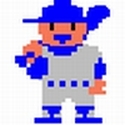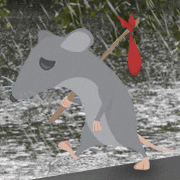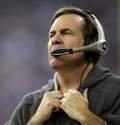|
My understanding is that the "humps" on a GPR image represent areas where objects of different dielectric constants meet (like a ceramic cask with air inside). A pipe would look like a hump that stays the same shape as you walk along the length of the pipe. A grave would be a very wide hump that disappears very suddenly when you reach the foot or head. Edit: that is to say, the screen captures above are vertical cross-sections into the ground. As you walk you could imagine stacking the screen shots side by side to extrude a long tunnel-shape.
|
|
|
|

|
| # ? Jun 7, 2024 22:41 |
|
Cask from 2004 wasn't a solid object anymore, it was broken into a few pieces.
|
|
|
|
Very Nice Eraser posted:My understanding is that the "humps" on a GPR image represent areas where objects of different dielectric constants meet (like a ceramic cask with air inside). A pipe would look like a hump that stays the same shape as you walk along the length of the pipe. A grave would be a very wide hump that disappears very suddenly when you reach the foot or head. Pretty much, yes! The downside of that means you have to go directly over the target; if you are looking for a box that is 1 ft on a side you'd better run lines 1 foot apart. That is a lot to look at. And unfortunately a small air-filled cask is going to look just like a rock because they are similarly-sized point-source targets. There's not enough volume of air to really be significant to the wavelengths you are returning from 4 feet underground. You'll just get the diffraction off the top of the box.
|
|
|
|
xie posted:Cask from 2004 wasn't a solid object anymore, it was broken into a few pieces. OK, I am not a Ground Penetrating Radar technician, but if it is ceramic in plexiglass, then any air pocket remaining alone could still produce a sufficient anomaly on the GPR scan, then also there is the ceramic and plexiglass. Dielectric Constants: Air ~1 Ceramic 10~15000 http://my.execpc.com/~endlr/dielectric_const_.html Acrylic 2.3~3.3 Earth 10~15 http://home.earthlink.net/~w6rmk/soildiel.htm e: ^Stupid rocks! http://www.kgs.ku.edu/Current/2001/martinez/martinez.pdf Corky Romanovsky fucked around with this message at 23:29 on Jul 16, 2013 |
|
|
|
Cask 4, Clevelandxie posted:Cask from 2004 wasn't a solid object anymore, it was broken into a few pieces. If the online accounts of Cask 4 are accurate, I get the impression that it was possible, if not likely, that the damage occurred during the actual digging for the cask.
|
|
|
|
Grand Poobah posted:The thing that I find interesting about the Russian pane is that none of the onion domes match in style, and none of them seem to be exactly symmetrical to themselves either. The windows in the middle dome are also different shapes. Yes, this could obviously be attributed to the artist's hand, or other elements blocking the views, or even a combination of elements from different buildings. But I'm starting to wonder if the 2 pieces in the middle of that image point to maybe 2 peninsulas and 2 islands on a shoreline that the artist hid within a generic onion dome sketch (to give a Russian link). The one on the right seems especially misshapen to me. I'd thought of the idea that maybe the space represented something else, too. With the scanning artifact in the OP version, I'd speculated that maybe it was the lower Hudson around the West Point area since it sort of seems to follow the flow of the river there. Looking at it in the later scans, though, it really doesn't. I hadn't noticed it when I originally posted it, but upon being repost you can roughly see the same shape between the "towers" here:  vs.  It looks like the mirror might be possible from the absolute most southern points of Governor Island, facing Ellis. But could you even see anything at that distance? And that would reopen the question of whether it would be possible to dig there. In any case, I have no idea what the Russian link would be to either there or the railroad/ferry terminal, other than perhaps just taking a swipe at the name Communipaw. GWBBQ posted:I can sort of see the "eye" in the painting in the book, but I'm pretty sure you're chasing scanning artifacts. I sort of thought as much. I finally broke down and ordered the book so that I can see this stuff for myself. I'm pretty positive that there's a shadowy "S" and maybe "M/W/3" (like the BOS in the presumed Boston picture) on the sleeve of cask 9 the guy, though. It actually looks like there could be a ton of stuff in that picture.
|
|
|
|
Megaman's Jockstrap posted:Cask 3 Urban Smurf posted:Cask 3
|
|
|
|
RoanokeSham I Am posted:I think that is not a spoon, but a lever. If you look at the end of the "handle" it looks like it curved and actually coming out of the wall. Ad the pea is not a pea but a post that is sticking out of the wall and is being used to hold the lever in place. A friend of mine ordered a copy of the book and I looked particularly hard at this part of the image since I wasn't 100% sold that it was a spoon. In the real copy of the book, it's pretty unmistakably a spoon. It's hanging from a thread that goes back up to the arm of the armor, just like the way the bells are hanging.
|
|
|
|
Cask 3 Mirlo Beach @ Rodanthe I've never seen very good evidence to support the Roanoke based theory(ies). Someone said there's a plaque with verbatim from the verse and there's exact images, but I've never seen them brought to light in a distinct and method based way which would fit either a Chicago or Cleveland style solve. Urban Smurf fucked around with this message at 21:41 on Jul 24, 2013 |
|
|
|
Urban Smurf posted:Cask 3 Mirlo Beach @ Rodanthe What about the part "the land near the window" which very closely resembles the outline of Roanoke Island? I'm starting to consider taking the 5+ hour road trip to Roanoke Island in a couple of weeks to see if I can piece together the end of the riddle. I'm thinking it very well should be near that Sea Gate or in the general vicinity. I'm not sure if/how it relates, but John White was a colonist and artist who did watercolors of the settlement. Could "Where White is in Color" have something to do with that? http://en.wikipedia.org/wiki/John_White_%28colonist_and_artist%29 More information on White. He apparently also made the first maps of the area (also, in color): http://www.nps.gov/fora/historyculture/hariotandwhite.htm Nocheez fucked around with this message at 16:07 on Jul 17, 2013 |
|
|
|
Palicgofueniczekt posted:OK, I am not a Ground Penetrating Radar technician, but if it is ceramic in plexiglass, then any air pocket remaining alone could still produce a sufficient anomaly on the GPR scan, then also there is the ceramic and plexiglass. Depending on where it's buried and your equipment, the challenge involved with detecting such a small box on a GPRS scan will range from really hard to impossible.
|
|
|
|
Psssst...does anyone here know who'd be interested in an official "Preiss's Secret"™ Divining Rod? It's been specially blessed during a reading of the verses and dabbed with a drop of Preiss's favorite brandy (the rest of it was for me). "When the cask is near, the rod will bend queer." Rod also comes with an officialistic Certificate of Digging Permission, printed on quality paper. Bidding starts at $250. I'm also working on setting up a Kickstarter fund to get some of Byron's DNA and cook up a clone. When it grows up enough, force it at gunpoint to find the casks.
|
|
|
|
|
Peenigrippe posted:Psssst...does anyone here know who'd be interested in an official "Preiss's Secret"™ Divining Rod? It's been specially blessed during a reading of the verses and dabbed with a drop of Preiss's favorite brandy (the rest of it was for me). "When the cask is near, the rod will bend queer." lmao Id settle for buying the book rights and making JJP tell us his clues.
|
|
|
|
Nocheez posted:What about the part "the land near the window" which very closely resembles the outline of Roanoke Island? Nocheez, maybe it is like verse 4's "seek the columns" which corresponds to image 4's columns. It's a very different sort of clue though, since the columns were structures at the entrance to a relatively small area. The outline of Roanoke Island is more like a map outline and is a very large area. Should we be looking at a map and all places in the "small area" nearby Roanoke's outline? I've challenged myself to consider a different more cryptic reason for that line where alternative uses of the words might give it different meaning. "land" could mean "a place where you land", such as bringing a boat ashore, or a runway for a plane. A window is simply something you look out of/from. Something I like as a fit is the lookout platform on the Rec Pole, which originally was used by the US Life Saving Station workers for spotting sea vessels that run aground.
|
|
|
|
I think the land near the window is pretty solid and matches the style of similar clues used in found casques.
|
|
|
|
New Orleans I just tried taking a fresh look at this - see what you think. At the place where jewels abound La Petit Fleur ("small flower", cf flowers in image), New Orleans Jewellers at 534 Royal St. http://lapetitfleur.com/ Apparently they've been trading in the French Quarter for over 40 years, though I don't know if it was at this location in 1982. Fifteen rows down to the ground Fifteen blocks south...  ...takes you past Lafayette Square with possible "clock-boy" match to the Confederate Memorial Hall at 929 Camp St.    http://www.confederatemuseum.com/ They have old flags and stuff...(also a chess set).   In the middle of twenty-one From end to end 21 bricks:  ...also another possible interpretation of the "fifteen rows" - 14 steps plus kerb.  Only three stand watch Dunno - possible reference to something in the museum? As the sound of friends Fills the afternoon hours Could refer to any gathering really. Here is a sovereign people Who build palaces to shelter Their heads for a night! New Orleans (from Sarmiento quote). Gnomes admire Fays delight Dunno. The litany refers to the "Fays of France" so there's a link there, and the fays also remind me of nearby Lafayette. The namesakes meeting Near this site Junction of Lee Circle and Andrew Higgins. 
BJG fucked around with this message at 10:47 on Jul 18, 2013 |
|
|
|
Jesus christ I can't believe I made it through 86 pages of this crazy awesome bullshit. San Francisco SF Bay-area goon here, I live in the East Bay but I could be convinced to take a special treasure-hunting trip to wherever. My boyfriend is an East Bay local and I showed him the alleged SF image. He definitely called out the window-tower-rock thing as being "Alcatrazy" and thought that the other rocks sort of looked like the waterfalls around Stow Lake in Golden Gate Park. Soooo then I finally agreed to go with him to pay the GGP bison a visit (after months of gentle wheedling on his part) and he very agreeably went along with my crazy staring at everything from different angles. I know GGP has pretty much been discounted, and I'm inclined to agree - the lamps don't really fit the silhouette, the Chinese pavilion had no matches, the waterfall area didn't ring any bells. The verse was also useless. I mean, it's an enormous park, there are tons of trails and nooks and crannies and poo poo, I didn't see but a little part of it. But it was fun to go treasure-hunting, we spent some of that energy on locating a few geocaches around the bison. I'm fascinated with this thread, keep up the good work everyone!
|
|
|
|
Sir Cornelius posted:Depending on where it's buried and your equipment, the challenge involved with detecting such a small box on a GPRS scan will range from really hard to impossible. Depending on whether you read my entire post and comprehend the "edit" at the end, your reply will range from really not making sense to having added little value. Not unlike this post.
|
|
|
|
Houston I'm still thinking about Houston, but I wanted some time away so that I could return to it with a fresh mind instead of falling into old pathways and lines of thinking. Right now, I'm looking at part of the cryptic verse: quote:What we take to be The first part is found verbatim in Melville's Pierre: The Ambiguities. I don't think for a second that was unintentional or misdirection. It's the kind of book he would have been familiar with and is popular with book critics and publishers simply because it's extremely difficult to read and decipher. The quote in question comes from this paragraph: quote:AS the vine flourishes, and the grape empurples close up to the very walls and muzzles of cannoned Ehrenbreitstein; so do the sweetest joys of life grow in the very jaws of its perils. It's pretty obvious he's talking about life here and in particular the life of Pierre's father. "Our strongest tower of delight" is our life -- or someone else's -- and it can be extinguished rapidly. Since this is immediately followed with "falls gently in December night", I think we should be looking at someone or something that died or ended in December and went away quietly. I remember the statue of Simon Bolivar mentions December -- it was erected on the anniversary of his death, December 17. I once thought that this was a key in Hermann Park, and I think it still might be. I wouldn't be at all surprised if the cask is buried near the Hermann Park Garden Center and particularly near Bolivar's statue. There's some speculation on Atropos and the Atropos key from the section about the "Three Weird Ones", but I don't think it's right. This tends to lead one to Shakespeare's MacBeth and the Three Witches which are often referred to as "The Three Weird Sisters". Only one is given a name, and it is not Atropos, it's Hecate. Reaching further, this part of the play is inspired by the Nordic poem Darrađarljóđ, where twelve valkyries weave (loom?) and choose who will die in battle. Only six of the twelve valkyries are named, and none of them are Atropos. Working backward from Atropos, I can make a connection to the Shakespeare play as detailed in this wikipedia article. One of them (fate) uses the name Wyrd which is the basis for the word weird, but that's only one of them and there's no strong correlation with Atropos. They're never directly referred to as "Three Weird Ones" in any way. It's possible to "get there from here", but I think it's a pretty tenuous stretch, especially considering that the section comes so far after "strongest tower of delight". einTier fucked around with this message at 00:29 on Jul 19, 2013 |
|
|
|
Verse 9 Shell, limestone, silver, salt This line is very interesting from a chemistry perspective. Seashells are made of Calcium Carbonate (CaCO3) Limestone is primarily Calcium Carbonate Silver (Ag) Salt is typically Sodium Chloride, but "salt" in the broader sense is the cation/anion result of an acid/base neutralization. CaCO3 is a salt. As far as what the two might have in common as an application, silver may be treated for tarnish by applying calcium carbonate in solution or paste. That reminds me, I use to polish my fishing lures with toothpaste. I'm still not completely sure of the object of this line of verse. I thought at one time it best described nacre such as the silvery mother of pearl shell of abalone:  I picked up a book from the 70's on the history of Roche Harbor (Afoot and Afloat in San Juan Islands was another book I researched) and read that the limeworks started in 1881 there produced 1500 barrels of lime a day, the largest producer west of the Mississippi. More about it's history here Should the line be designed to capture the sense of "think of a pretty kind of sea shell", or the word "limestone" be a narrowing clue, the strong central source for the commodities abalone or limestone might both be used to point to San Juan Island, but only as an after thought, since both may be found in many other places as well. An interesting connection to image 12 is the color hues of abalone may be seen in the circle filled panels. The wiki on abalone describes the colors of the shell and it's pearls: the iridescent nacre that lines the inside of the shell varies in color from silvery white, to pink, red and green-red, through to Haliotis iris, which shows predominantly deep blues, greens and purples. Urban Smurf fucked around with this message at 01:11 on Jul 19, 2013 |
|
|
|
Eintier, the "My daughter, my daughter" part reminds me of the Goethe poem Erlkonig, "My father, my father" when Death comes for a man's sick child and persuades the boy to come away with him. I really like the Atropos Key connection.
|
|
|
|
Houston, again I'm falling into that same old trap. I can see a connection to the Bolivar statue, and I want to believe that's where it is. Here's a good picture of the statue.  I'm trying to make myself believe that the "leaves" on the front of his jacket are the "Small, split, Three winged and slight" referenced in the poem, which would seem to indicate the cask is buried near this statue. But I have a couple of problems. 1. There's no corresponding imagery in the painting. I'm getting there almost entirely by the verse, and while there's not much in the image, there's virtually nothing I can match up. Everything that I could make a case for is a real stretch. 2. I can't make Bolivar fit anywhere in the "center of four alike". He's number 15 on the map on this page. I'm pretty sure this is him off by his lonesome near the y-shaped path. There are four other busts that line the path on the opposite side, but he's not in the middle. I doubt the statues moved, but it's nearly impossible to verify how much might have changed in this location. 3. Assuming that Bolivar is correct, then the 982 must correspond to the old 982 locomotive. But how in the world do you get to the Memorial Garden from there? It's a very long walk from the train to the park -- by my reckoning, it's at least 1/4 of a mile (0.4 kilometer). We're a third of the way through the poem by the time we get to the 982 line -- would we really walk so far after that? I'm just not convinced. Thoughts? einTier fucked around with this message at 00:04 on Jul 21, 2013 |
|
|
|
Cask 2 Verse 6 I really like the Edwin Booth connection to May 1913, but I've been thinking about the theme of lynching since a "golden pear" hanging on a branch that doesn't look like a pear bearing branch in the first place might be thought of as a "Strange Fruit", which was a poem written by Abel Meeropol, a white, Jewish high school teacher from the Bronx and a member of the Communist Party, as a protest against lynchings. The neck-chain with the Sumter shaped "face" might also be symbolic of lynching. In May of 1913, Leo Frank was arrested for the murder of Mary Phagan (actually murdered on Apr. 26th). The Leo Frank Trial was the one article headline that I found interesting in my careful search of the New York Times archives (I read them all for the month of May in 1913). Frank became the only known Jew lynched in American history. http://www.jewishvirtuallibrary.org/jsource/anti-semitism/frank.html Unfortunately, I'm not seeing how this might apply to Charleston.
|
|
|
|
Milwaukee This is probably not of much help but, I had 10 minutes to spare yesterday so I walked 6 blocks and grabbed a few shots of Plankinton Circle or whatever it's called in the Grand Ave Mall. Yes, I spend all my free time looking for clues now. I hope to get to city hall soon.   Note: The dark areas near base in fountain are hordes of pennies.  edit: All my Mke Secret-related photos are here: http://www.flickr.com/photos/97715723@N04/ crashdome fucked around with this message at 16:12 on Jul 20, 2013 |
|
|
|
Cask 10 / Verse 8 - Milwaukeecrashdome posted:
Looks like quite few people went there to cast in copper. I know you've been working on that interpretation. Edit: To contribute, I haven't been following Milwaukee as close as some of the others, but I quite liked this comparison that TipsyMc posted on page 41. Unfortunately, it didn't seem to gain too much traction. Did I miss something that caused this to get dismissed?  
Merlot Brougham fucked around with this message at 20:45 on Jul 20, 2013 |
|
|
|
Merlot Brougham posted:Cask 10 / Verse 8 - Milwaukee Oh poo poo! Right next to the line referencing ascending steps too! I think you're on to something. Although it's the line before it, any idea step on nature?
|
|
|
|
Cask 11, Verse 3, Boston Someone had mentioned the USS Constitution (Old Ironsides) as the "metal walls". It should be noted that the ship lies at anchor in the shadow of this "green tower of lights", the Tobin Bridge... 
|
|
|
|
Nnep posted:Oh poo poo! Right next to the line referencing ascending steps too! I think you're on to something. Although it's the line before it, any idea step on nature? Yeah, you would "cast in copper" before you ascend the steps. While I think it would be nice to tie the previous lines in, if that's the place, you could just proceed from there.
|
|
|
|
einTier posted:Yeah, you would "cast in copper" before you ascend the steps. While I think it would be nice to tie the previous lines in, if that's the place, you could just proceed from there. I'm extremely intrigued by the wordplay and it seems to be the sort of thing Preiss would do. Combined with the number of steps, I think we have a raging clue here.
|
|
|
|
TX297 posted:I'm extremely intrigued by the wordplay and it seems to be the sort of thing Preiss would do. Combined with the number of steps, I think we have a raging clue here. It's more than that. Back on page 53 we were having a pretty lively discussion about this very thing. This kind of got overlooked: crashdome posted:It's worth an investigation. I wanted to head over there myself so if you can get there first, I say go for it! So, we have quote:Cast in copper -- the fountain full of pennies [edit] Just one problem. That compass is part of an art display called The Wisconsin Workers Memorial. It was built in 1995.  You can see more pictures of it here, if you like. According to wikipedia, this display takes up most of the park. Anyone have any idea what the park looked like before?
|
|
|
|
Cask 10 Dr. Bit/crashdome, you've found the strongest most definitive answer to the Milwaukee puzzle so far. The Plankington Arcade holds the key to this. Nice work! If three lines of the poem fit that one spot, the wishing well, the number of steps, and Grand Ave., that puts a lot of importance on that location. Following the instructions to climb the stairs means you have just traveled in a circular path (flattened) and now you're wondering WTF did Preiss want me to walk in circle? The next line "pass the compass and reach" fits, since a compass is a tool used to draw a circle. I propose that the circle of stairs is the "locus" of a larger circle. The question then is what determins the radius of that larger circle? How about the tangent of Locust Ave? Next question, where's a good place to bury a casque near wherever that large rear end circle passes? How about a spot near 200 degrees?  Some other random thoughts, From woman, with harpsichord From woman = child, born to play harpsichord Maybe this fits some of the speculation that there's a "helmet" connection to many of these puzzles. A "secrete" was a form of skullcap helmet and this is the first time I ever heard of a caul while reading about Polish wunderkind "Walter" Valentino Liberace, who was a child prodigy pianist who's first regular paying job was at the Plankington Hotel's Red Room, the site of the circle of stairs. Does the cowl worn by the woman in image 10 act as a clue to consider a child known to be born with a "caul", meaning they will be lucky or successful? I found a citation from a book published in 2000. Would be nice to see the citation that book used. Was there a famous interview around 1980 where Liberace spoke of his birth story? I have to wonder if Liberace's importance to this puzzle is simply to connect his middle name Valentino with the name of the fantasy fiction character Lord Valentine, the juggler,  Lord Valentine's Castle was published by Bantam Books Publishing in 1980, it won the Locus Award in 1981. This is the cover art from July 9th, 1981. "The locus of a point moving at a fixed distance from a center point is a circle". The word "locus" is found in the word "locust". This is making me dizzy. Just out of curiousity I googled "Silverberg and Preiss" and discovered they collaborated on The Ultimate Dinosaur (1992). I wonder if Silverberg ever said, "yo, I like the juggler painting you used in The Secret..." Wikimapia measures the Plankington Arcade at approx. 2.243 miles from Locust Ave. I've carefully measured the line extending along the 200 degree mark to a spot that looks extremely close to 100 meters northwest of Kosciuszko Park. Walk 100 steps southeast (you'll have to cut through the southwest corner of the Montesorri School)and you're standing at the northwest corner of Kosy Park. E: I was unable to find any good citations for where Liberace's birth story was discussed prior to 1982. I'm going to have to consider the hood/cowl on the woman as not a clue to the effect of being a "caul" reference. It seemed too far fetched to begin with. The Liberace connection to the Plankington Arcade is also a bit over-the-top, so nix Liberace from the list of usable references. The Robert Silverberg book cover is still a great comparison, but I feel it does nothing purposeful. I can't recall the details of the story, not that it matters. Urban Smurf fucked around with this message at 04:35 on Jul 24, 2013 |
|
|
|
Merlot Brougham posted:Cask 10 / Verse 8 - Milwaukee I thought it was a good clue  You could see the City Hall spires from the location of that sculpture, much like in the painting. You could see the City Hall spires from the location of that sculpture, much like in the painting.Much of the area where the sculpture is (the Riverwalk) went through extensive renovations in the late 80's. I'm kind of leaning to the idea that if the cask was buried around there, it's long gone.
|
|
|
|
While I think the 92 steps is a strong clue as its more exact than the grand staircase as far as we know, I'm not going to make any definte conclusions based off one or two clues. I wasn't the only one looking around there also. Don't give me too much credit. I just wanted to record visually all the staircases we think fit so we can expand from there. One reason I want to get to city hall is to verify through pics the 92 steps there too. I'll go back to the grand staircase also. One thing I've learned from reading this thread is small assumptions stated without solid proof seem to carry on as fact and I want to avoid that as much as possible in my own investigation of these theories and to help get others who don't live here some "on the ground" assistance. So throw out your ideas and I'll try and visit them in my spare time. Although it seems I've been very busy lately. So, it'll most likely be visits to areas as I happen by and have the moment to snap a few pics.
|
|
|
|
einTier posted:Just one problem. That compass is part of an art display called The Wisconsin Workers Memorial. It was built in 1995. quote:In 1835 five Milwaukee pioneers: Byron Kilbourn, Solomon Juneau, Albert Fowler, James McCarty and Archibald Clybourn donated the 1.2 acre site to the City of Milwaukee.
|
|
|
|
Milwaukee That's all super but, the statue the compass is on was, as far as I can find, established in 1995. Especially since it also has a pc keyboard as part of the elements. I'd love to be proven wrong though. Edit: actually, Nevermind me. I'm not sure what the purpose of that quote is regarding. Edit again: ok after getting my head out of my rear end and finally rereading the last few posts, I tried to find bandstand pics but failed. Also, it's sorta in the wrong direction anyways. There is grass along the river. Maybe something worth checking in that direction. crashdome fucked around with this message at 23:16 on Jul 21, 2013 |
|
|
|
I was just sharing what I was able to find about the history of the park. Google results are a pain in the rear end to sort through and the Milwaukee Historical Society doesn't have anything relevant available online.
|
|
|
|
^^ Yeah, I finally figured out what you were saying. I don't know why I was so confused at first. I guess that makes it worth a visit and maybe even asking a few people about it. Here's areas of high interest to me in Milwaukee that I plan on visiting: The "new" Pere Marquette Park Zeidler Park (The "old" Pere Marquette Park) The area where the Milwaukee River meets the Menomonee River Lake Park (again) Northwestern Mutual Building I tried to look in other areas outside the center of the city but, I feel the trail goes too cold too quickly. TipsyMc posted:I thought it was a good clue Pere Marquette is across from it and yes, that might make it an "impossible" find.
|
|
|
|
Milwaukee Some thoughts on this compass theory, The solution method doesnt really look too complicated. Step 1: find a place near City Hall that has 92 steps. Step 2: use a compass set from locus to Locust and draw a circle on your map. Step 3: look for a place that is 100 paces southeast from a point on the circle that fits with the remaining lines of poem. Step 4: find birch trees. Step 5: find proud tall fifth, Kosciuszko and his funky hat. Step 6: find tree that fits cape outline, its like the Chicago arch or Cleveland wall sketches. Step 7: rack your brain to fit the final pieces together... Why place 0 degree mark at top? It could've been set at the 3 o'clock position (as is common in angle positioning), but since Locust Ave. seemed like the first nearest point of concern, let's set that as zero. The "walk 100 paces" line serves as an error correction, since the convenience of choosing a radius distance on the map that matches perfectly with Locust Ave. only brings the arc close to Kosciuszko Park. The most direct route of "foot travel" involves cutting across the diagonal edge of the school's sports field. There's a row of houses there and some fencing to prevent travel. I don't know if that was the case in 1981. I don't know if it matters that much. Preiss could've went through the open entrance to the field on the Windlake Ave. side and then counted paces along that edge of field that connects to the Becher St. entrance to Kosciuszko Park.  I've found a birch tree just south of this main entrance along 9th street. Using aerials I believe I've found 3 more birch trees that you would pass in order to get to the Kosciuszko monument. Confirmation of this birch tree count should be easy once someone has the time to take a 10-15 minute stroll through the park. E: also, a good reason for the two words "and reach" that follow the line "Pass the compass..." might be to fit the 100 paces correction to get to the park entrance. Here's some approximation from the wikimapia tool: 
Urban Smurf fucked around with this message at 04:53 on Jul 24, 2013 |
|
|
|
Milwaukee I just checked that location out for you. I want to point out I have bias in that I don't subscribe to your theory at all as it makes no use of various keywords in the poem. I am, however, going past that park everyday and I am more than happy to investigate anything if I can do so easily. I tried to look around without any bias and I will say that your birch tree count does not add up no matter how much I tried. The 4th Birch you pointed out via PM to me just isn't there. Click for crappy panorama of the location of the 4th birch tree I tried to take:  Here is a sub-set of pics I took as I biked through the park using the guide you gave me via PM. I tried to title the pics as descriptive as I could. http://www.flickr.com/photos/97715723@N04/sets/72157634756599338/with/9344668183/
|
|
|
|

|
| # ? Jun 7, 2024 22:41 |
|
fishbone posted:Cask 3 Thank you... "look north at the wing" makes a ton of sense in this interpretation. As someone who lives nearby and visits this area often, I really don't think that anyone would bury something on the beach or in dunes, etc, though. They're way to transient, even over short periods of time.
|
|
|































